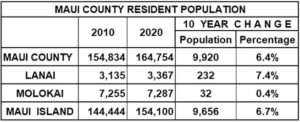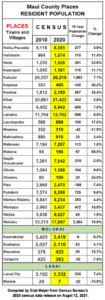Last week, the U.S. Census Bureau released the long-awaited results of its once-a-decade tally. The voluminous data produced pretty paltry reporting when it came to Maui County. Our population has grown to 164,754 residents from 154,834 in 2010. The Maui News couldn’t even be bothered to include that 2010 figure in its hurried coverage. The Honolulu Star-Advertiser story was slightly more informative when it came to Maui. It quoted state economist Eugene Tian, who said he was surprised by the Maui results. Our population growth didn’t even reach the previously projected increase of 173,000, he said, adding that he hadn’t had time to crunch those results in search of an answer.
Luckily, we have Dick Mayer, long-time resident and community activist, who taught economics and geography at UH Maui for 34 years, and who was up until about 5 a.m. on Friday morning reviewing Maui’s numbers and putting them into charts that he disseminated to an email list that included Politics On Maui. This is the first of a three-part series presenting those findings, with commentary from Mayer, who has participated in the Maui census since 1970, thus bringing 50 years of expertise to reviewing the data each census produced.
Before we get to the charts, here’s an important caution from Mayer about the 2020 results: they might be skewed. “We just don’t know how accurate these numbers are because the census was conducted right when COVID hit, and that threw everything off and is one reason the results have been delayed nine months,” he explained. A second reason for questioning the numbers’ accuracy, he says, relates to then-President Donald Trump’s unsuccessful efforts to put a question about citizenship into the official census questionnaire. “That may have intimidated a number of people here who don’t have legal status.”
That said, here are today’s charts, which relate to the 9,920-person increase in Maui’s population, which Mayer further broke down into resident populations across Maui County towns and villages.

Mayer’s big takeaway: The numbers show only a modest change in the county’s population compared to previous decades’ increases. How is that possible, I asked, given repeated complaints that the island is more crowded than ever. In addition to his earlier caveat about a possible lack of reporting by undocumented residents, Mayer suggests that island-wide turnover may play a factor. “We keep meeting new people on Maui, but they come and work here two or three years and then leave. And they’re replaced by somebody else who just moved here. So, although it may seem like you’ve got a lot of new neighbors, they’re just replacing the old ones. We don’t know for certain because no one keeps track. The county has been negligent in keeping track of the trends. It just relies on the state to give them some numbers — and now the feds. It doesn’t do anything to verify them, nor does it do any data collection of its own.”

When it came to breaking down the population increases and decreases throughout our towns and villages, Mayer said a couple of things jumped out at him. “What struck me the most was that Kahului has grown so significantly in the last decade (from 26,337 to 28,219 residents), and Wailuku (from 15,313 to 17,697).”
Mayer attributes that to “all the new housing that’s gone up in Central Maui.”
Mayer was surprised that the population in Kihei didn’t show a bigger increase, but suggested that the answer may lie in the number of residences that have been converted to rentals. The same holds true for areas like Paia, Napili-Honokowai, Maalaea and Manele on Lanai. “So, the number of residents may have gone down in these cases,” he said. “It looks like residents in the coastal areas—where tourists want to stay—are possibly finding it more lucrative to transform their units into rentals. Or, they have been replaced by out-of-town owners.”
Why are these population breakdowns important? A main reason is that these 2020 numbers will be used next year by the state to define legislative senate and house districts. As Mayer explains, our current legislative allocation (three Senate districts and six state representative districts) probably won’t change. “But due to the population changes, they’ll have to shift the lines on the outside boundaries of some districts, especially to consider central Maui’s population growth.”
Part Two: Is Maui becoming ghetto-ized? A look at Maui’s 2020 population/housing distribution.



Pingback: Maui Census Part Two: Where Have All the Residents Gone? “Vacant Housing” High in West, South Maui